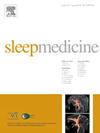Infant colic and sleeping problems from early childhood through adolescence
IF 3.8
2区 医学
Q1 CLINICAL NEUROLOGY
引用次数: 0
Abstract
Our aims are 1) to assess whether sleeping problems persist from early childhood until adolescence, and 2) to investigate whether infant colic is associated with more sleeping problems throughout childhood and adolescence. Furthermore, we explore a moderation by parent-infant room sharing of potential associations between infant colic and sleeping problems. Data originate from a prospective longitudinal study in a healthy community sample (N = 185). Infant colic data were collected using cry diaries, filled in by the mothers for four days at age six weeks. The number of weeks of parent-infant room sharing from zero to six months of age were recorded using daily maternal diaries. Sleeping problems were assessed through maternal report at ages 2.5, 6 and 10 years, and child report at ages 12.5, 14 and 16.5 years. We used a score of Total Sleeping Problems, as well as subscales on Night Waking and Sleep Duration. Correlations were found between sleeping problems measured from 2.5 through 16.5 years for the Total Sleeping Problems, as well as for Night Waking and Sleep Duration. Compared to participants without infant colic, those with colic showed higher scores of Total Sleeping Problems between ages 12.5 and 16.5 years. We found no differences in sleeping problems between 2.5 and 10 years, nor evidence of a moderation by room sharing. Current findings suggest that sleeping problems developing in early and middle childhood persist throughout adolescence, and that children with infant colic may be prone to developing sleeping problems during adolescence.
从幼儿期到青春期的婴儿绞痛和睡眠问题。
我们的目的是1)评估睡眠问题是否从儿童早期持续到青春期,2)调查婴儿绞痛是否与整个儿童和青春期的睡眠问题有关。此外,我们还探讨了父母-婴儿房间共享对婴儿绞痛和睡眠问题之间潜在关联的调节作用。数据来自健康社区样本(N = 185)的前瞻性纵向研究。婴儿疝气数据是通过哭泣日记收集的,这些日记由母亲在六周大时填写四天。使用每日母亲日记记录从0到6个月大的父母-婴儿共用房间的周数。通过母亲在2.5岁、6岁和10岁时的报告以及儿童在12.5岁、14岁和16.5岁时的报告来评估睡眠问题。我们使用了总睡眠问题评分,以及夜间清醒和睡眠持续时间的子量表。研究发现,从2.5年到16.5年的总睡眠问题,以及夜间醒来和睡眠时间之间存在相关性。与没有婴儿绞痛的参与者相比,那些有绞痛的参与者在12.5到16.5岁之间表现出更高的睡眠问题得分。我们发现,在两年半到十年之间,睡眠问题没有差异,也没有证据表明,房间共享可以缓解睡眠问题。目前的研究结果表明,在儿童早期和中期出现的睡眠问题会持续到整个青春期,而患有婴儿绞痛的儿童可能更容易在青春期出现睡眠问题。
本文章由计算机程序翻译,如有差异,请以英文原文为准。
求助全文
约1分钟内获得全文
求助全文
来源期刊

Sleep medicine
医学-临床神经学
CiteScore
8.40
自引率
6.20%
发文量
1060
审稿时长
49 days
期刊介绍:
Sleep Medicine aims to be a journal no one involved in clinical sleep medicine can do without.
A journal primarily focussing on the human aspects of sleep, integrating the various disciplines that are involved in sleep medicine: neurology, clinical neurophysiology, internal medicine (particularly pulmonology and cardiology), psychology, psychiatry, sleep technology, pediatrics, neurosurgery, otorhinolaryngology, and dentistry.
The journal publishes the following types of articles: Reviews (also intended as a way to bridge the gap between basic sleep research and clinical relevance); Original Research Articles; Full-length articles; Brief communications; Controversies; Case reports; Letters to the Editor; Journal search and commentaries; Book reviews; Meeting announcements; Listing of relevant organisations plus web sites.
 求助内容:
求助内容: 应助结果提醒方式:
应助结果提醒方式:


